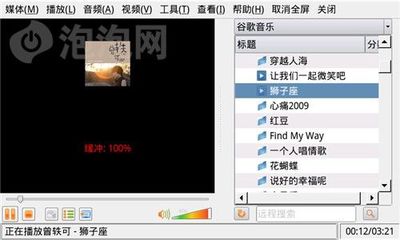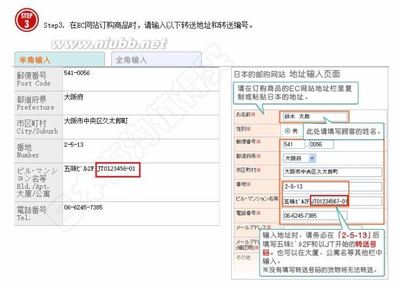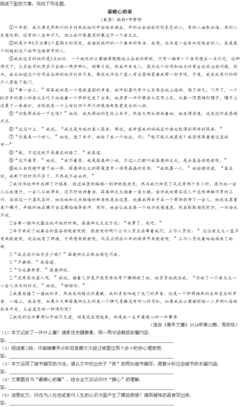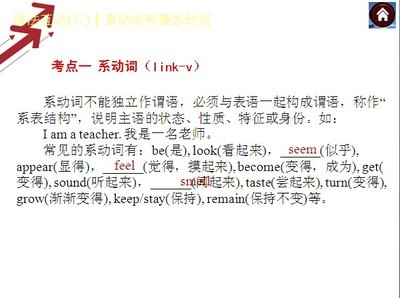I have nothing to say. (nothing做及物动词say的逻辑宾语)
I have a letter to write. (letter是及物动词write的逻辑宾语) 而以下情况有介词:
I have a pen to write a letter with. ( 用钢笔写信,所以要有“用”字,故加with。)
The zoo is not a good place for animals to live in。
(“住在动物园里”,zoo是live in的逻辑宾语,故不及物动词live加介词in. )

Tom has no friends to talk to. (friends 是talk to的逻辑宾语,to不可少。)
He runs too fast for us to catch up with. (he是catch up with的逻辑宾语,带with。) There are no seats to sit on. (坐在座位上,故sit后要加on。)
2.(a) little / (a) few: 1few,little“几乎没有;少”否定词。few加可数名词复数, little加不可数名词。 There is little water in the bottle, is there? (前否定,后肯定)
Tom is so shy that he has few friends。
2a few“一些”肯定词,加可数名词复数; a little“一些;一点”也是肯定词,加不可数名词。 Tom is not an Englishman , but he knows a little English。
3另外,在too, very, so等词后用few, little; 在only, just, still等词后用a few, a little. 而quite a few / a little 都译为“很多”,分别相当于many和much。
(注:有时a little…。。并不是固定短语。如: a little sheep译为“一只小羊”)
3.及物动词+副词:put on (穿上) / put off (推迟) / put away (把…整理好) / put up (举起,搭起,挂起,张贴) / put down (放下) / put out(扑灭); break down(损坏,倒塌);
turn on(打开) / turn off (关闭) / turn up (调大) / turn down(关小); get back(取回);
use up(用光); cut up(切碎) eat up(吃光) sell out(卖完) cheer up(振作)
give away(赠送) / give out(发放) / give up(放弃) / give back(归还); pick up(捡起、拿起)
try out(验证) / try on(试穿); ring up/ call up(打电话); clean up / out (打扫干净);
set up(成立); think up(想出;想起); hand in (上交) / hand out(分发;散发);
fix up(修理); work out(算出) dress up(打扮); help out(帮人解决);
keep off / keep out(阻止;挡住); take off(脱下) / take away(拿走) / take out(拿出);
look up(查找) / look over(仔细查看); throw away / off (抛弃) wake up(叫醒); write down(写下); let down(使沮丧); make up(编造、组成); set off(激起、触发)
注:名词做以上短语的宾语,可放在它们中间或后边;而代词做宾语,只放在中间。
4.as……as用法:中间加形容词和副词原级。1和…一样… His room is as big as mine。
He runs as fast as I do / me / I. You should keep the room as clean as your brother’s。
2as…as possible / sb can “尽可能…” We went there as soon as possible。
—7—
Listen to the teacher as carefully as you can. He went there as quickly as he could。
3有些短语有几个意思:as soon as 和…一样快;一…就…; as much as和…一样多;多达; as long as和…一样长;长达;只要; as well as和…一样好;和…一样;
as far as远达;就…来说 (as…as…在否定句中也可说so…as…。)
也可表示倍数: This room is twice as big as that one. 这个房间是那个房间的两倍大。
5.prefer用法:prefer sth to sth 或 prefer doing sth to doing sth。“比起…更喜欢…”
prefer to do sth rather than do sth宁愿…也不愿…
若单独一个prefer,和like 用法类似,后接 to do sth 或 doing sth “更喜欢做某事”
6. some-, any-, every-用法:1some-“某~,一些~”,用于肯定的陈述句中。
I have something to tell you. Maybe somebody has taken it。
若用于疑问句中表示期待对方肯定的回答或表示请求或建议。
Why not ask somebody to help you? Shall we give him something to eat?
What about some milk? Could you please lend me some chairs?
Will you buy me some books? May I give you some tea? Would you like some milk?
在一些”do some…”短语中, 即使是疑问句中, some也不变为any. 如:
Will you do some washing next Sunday? 这些短语有:
do some shopping / cleaning / cooking / sweeping / washing 等。
2any-, 在疑问句中仍译为“某~,一些~”Do you have anything to say?
Is anybody in the house? Have you seen it anywhere?
在if 引导的句中,常用any. 如:If you have any water, please give me some。
在肯定句和否定句中译为“任何~” You may put the box anywhere in the room。
He is taller than any other student in the class. We won’t have anything to eat now。
3every-“每~”,强调所有,既包括此也包括彼。
Is everybody here?-No,Tom and Lucy have asked for leave。
The glass was broken, and the water went everywhere。
7.动词时态和形式:八个时态:一般现在时、 现在进行时(am / is / are + v.ing)
一般将来时(will / shall / be going to+动词原形)、 一般过去时、 过去进行时(was / were + v.ing)、 现在完成时(have / has + v. 过去分词)、 过去完成时(had + v. 过去分词)、过去将来时(would + v. 原形) 六个形式: 原形; 过去式(规则的加ed);
过去分词(规则的加ed); 第三人称单数(加s / es); 现在分词(v.ing); 带to不定式。
8.if / whether区别:if 如果(引导条件状语从句) / 是否(引导宾语从句)
—8—
Do you know if he will go to the post office? If he goes there, I will ask him to buy me some stamps. 两个if, 前者“是否”;后者“如果”,观察其后时态的不同。(各见语法1、2)
whether“无论”引导让步状语从句 / “是否”引导宾语从句(相当于if)
都译为“是否”时,whether可接or not, 也可接带to不定式。而if 则不可。
另外,if可接any-单词,常不接some-单词。 (见语法28.)
9.因为:because, 常是对why的回答,语气最强。位置:Because…, …或…, because…。
 爱华网
爱华网



